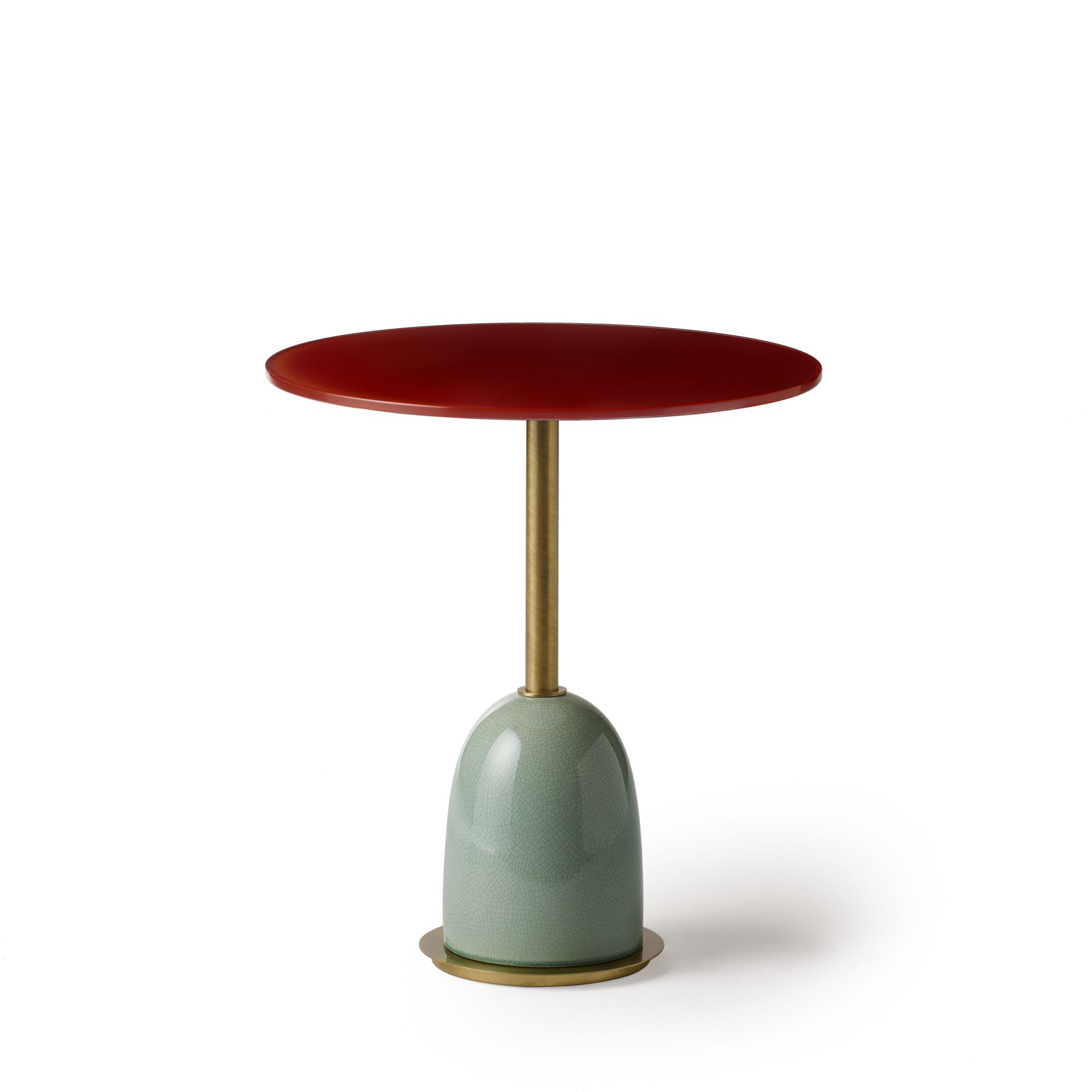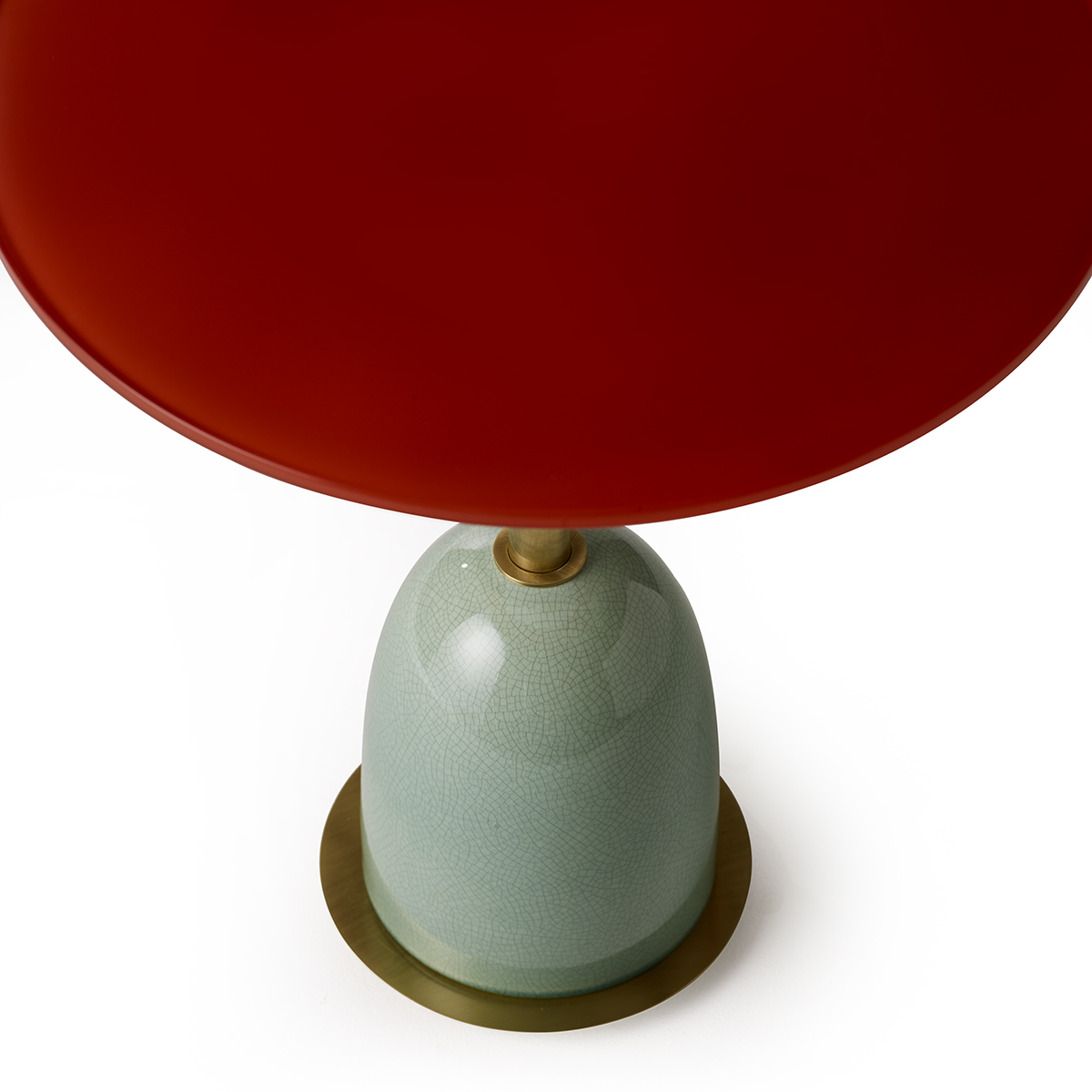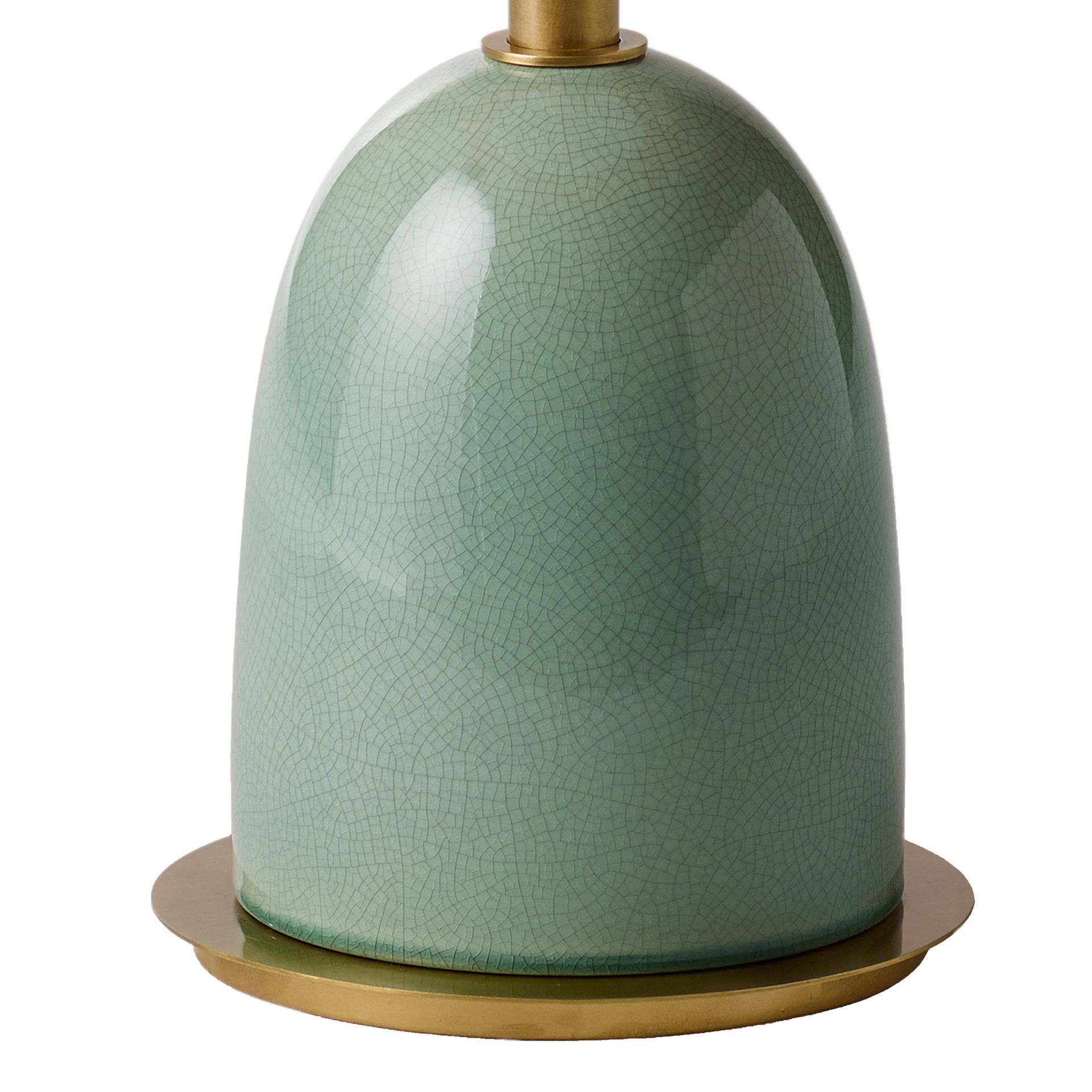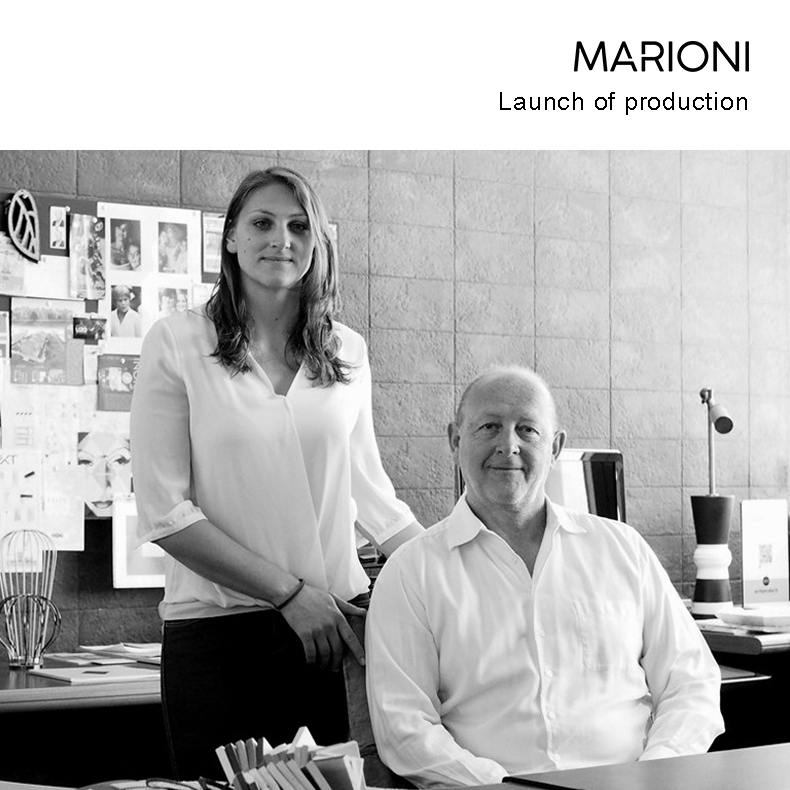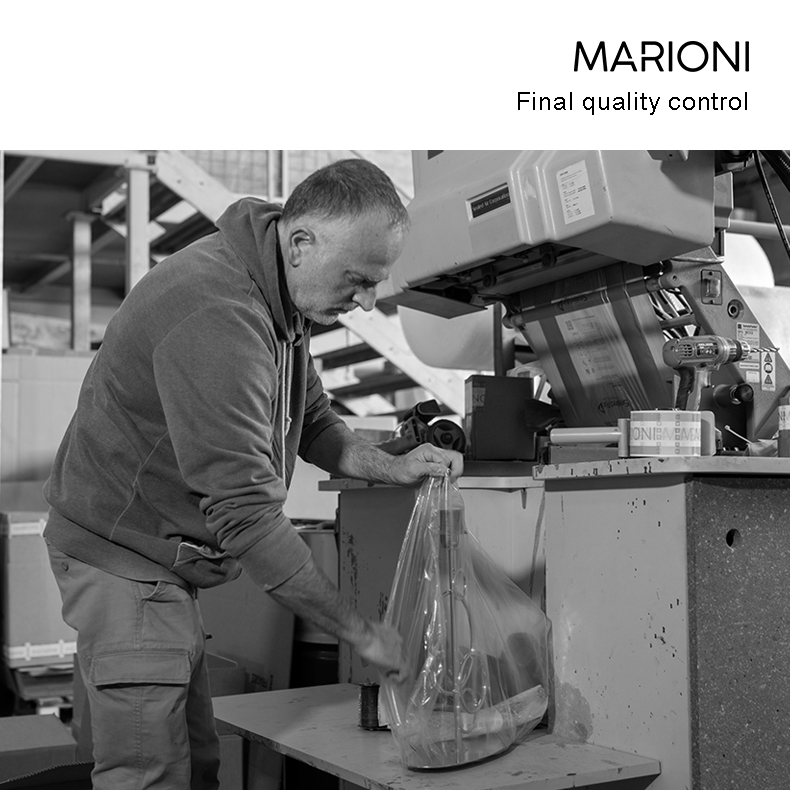Pins - Round side table
Furniture
Pins round side table in brass with back painted glass top and ceramic glazed base in contrasting color. Available in different colors and finishes.
Discover the infinite variations of decoration and customization that we make available for your projects. The side tables of the Notorious collection have been designed with the intention of offering a refined and demanding clientele exclusive proposals that arise from the perfect mix of refinement of materials and deep knowledge of craftsmanship.
Product sheet 
| Product code | 02926 |
| Dimensions | h.55xdia.50 cm |
| Weight | 13 Kg |

Notarization: Pins - Round side table
Blockchain: etherna-mainnet
Registration date: 4/28/2023 1:29:48 PM
Address explorer: 0xAdEb8B295611b127C8c55B6cb7f8ff8e5AF65825
Notarization hash SHA256 encrypted:
Notarization JSON data:
Verify notarization
On Explorer The production stages
The production stages
-
1/2 Launch of Production
From 9/30/2024 To 9/30/2024
MARIONI Via G.Giusti 199 - Calenzano (Calenzano) - Province of Firenze, Italy
For each product produced, a precise procedure is followed, which is outlined in the Quality Manual, as the company is certified to ISO 9001-2015. Specifications are defined at the order phase and the characteristics can be found on the Product Sheets, available on the website www.marioni.it.Every year, a third-party entity verifies compliance with internal procedures and monitors and evaluates the maintenance of company objectives.
After the launch into production, the system generates Mandates that are delivered to the Production Manager. In addition to the Mandates, Purchase Proposals are automatically created for the Supplier, which the Purchasing Department manages based on parameters such as: stock levels, minimum orders, minimum stock levels, etc. Depending on the collections and lines, there are different processing phases.
Checks during production
Each Department Manager coordinates and controls the work of the operators to ensure:
• the correct execution of Work and Control Instructions;
• the verification of the progress of the work to control that all items in the program have been produced and have passed all processing phases.
For us, quality and sustainability have always been company priorities.
All of our personnel are committed daily to complying with the highest quality and service standards. Lamps, furnishings, upholstered furniture and exclusive furniture, although entirely handmade with artisanal care, must still undergo the strictest stress tests and guarantee their performance over time.
Active and constant participation in Research and Development tenders, Internationalization and Digitalization at regional, national and European level confirms our commitment to continuous improvement of performance and collaboration with other partners in the Tuscan regional supply chain.
-
2/2 End of Process
From 10/22/2024 To 10/22/2024
MARIONI Via G.Giusti 199 - Calenzano (Calenzano) - Province of Firenze, Italy
Before wrapping and packaging, each product, whose compliance is guaranteed by the self-control system required by the ISO 9001-2015 standard, is always subjected to a series of final checks, the methods of which depend on the type of product.
Our staff is suitably trained and qualified for this purpose. The implementation and results of production control are periodically checked by the Quality Manager using the following tools:
- Internal Audits
- Management of Non-Conformities
Sample surveys and analysis of data relating to the management of Non-Conformities found on the process/finished product are periodically carried out. This analysis may lead to requests for Corrective or Preventive Actions.
But the relationship with the client does not end with the shipment of the product. The history of the company is so full of personal experiences and human values that make it unique in its kind. The relationship that arises between the customer and our creative team goes beyond a simple supply, often resulting in a positive and continuous exchange of stimulating ideas and innovative proposals: a vision that makes Marioni emerge in the variegated Italian entrepreneurial landscape.
The adoption of socially responsible behaviour, monitoring and responding to everyone's economic and environmental expectations also achieves the goal of acquiring a competitive advantage. In fact, a product is not appreciated solely for its external or functional qualitative characteristics; its value is largely estimated for non-material characteristics, such as customization services, the image and finally the history of the product itself.
SUSTAINABILITY
Marioni is a family-run company, now in its third generation, and pursues a cultural and ecological mission alongside its commercial interests. Preserving our environment is expressed in every action performed and it is manifested in how our products are developed and manufactured. Marioni makes use of many different materials and the ongoing development of this material portfolio is a central focus of its sustainability efforts. In order to reduce the impact on the environment, Marioni is working intensively to replace all primary materials with recycled ones when it is possible.
With Legislative Decree 116/2020 which transposes the EU directives on waste, starting from 01/01/2023 all packaging are subject to the obligation of environmental labeling. Based on what is indicated in the Decision 97/129/EC regulation, the minimum information to be reported on the packaging are:
• Type of packaging: box, etc
• Material identification: alphanumeric identification coding.
• Reference material family: paper, plastic, etc. and the indication of the type of collection.
More information here
https://www.marioni.it/pdf/Sostenibilita%20-%20Sustainability.pdf
PREVIOUS PHASES
02_CLAY PROCESSING
Ceramics involve processes that have been handed down over time and have not undergone substantial changes over the years. We use terracotta (clay that contains additives and fluidizers) as our raw material, which is soft and porous. It can be processed by casting or pressing.
Casting
In this modeling technique, a plaster mold is prepared that replicates the object that is to be reproduced in negative. Clay is then poured into the mold, and after an appropriate amount of time during which the plaster provides sufficient thickness to the object by absorbing the water content, the excess material is poured off and the object is allowed to harden. It is then extracted from the mold and finished by hand.
Pressing
Another technique is called pressing, where harder clay is used and two mold matrices are prepared, one male and the other female. The molds are mounted on a press, placing them facing each other with a sufficient layer of clay to shape the object. At that point, the equipment is activated and the two surfaces come together, shaping the clay.
The next phase is Drying
Regardless of the technique used, it is necessary for the clay objects to dry completely in the air. This phase requires particular care. Even and uniform drying ensures durability of the finished object and especially the consistency of its shape. Uneven drying can cause deformations. Only after this phase can the firing process begin. Drying allows the object to lose its residual moisture and plasticity. Following drying, the product undergoes a 1% reduction in volume.
Firing
After the delicate drying phase, the firing process begins. This takes place in specialized kilns powered by natural gas or electricity, which reach temperatures of around 1050°C. The process takes approximately 8 hours to rise and 8 hours to cool down. It is necessary for the temperature to follow gradual and predetermined growth and decline curves. Once the product is extracted from the firing chamber, it is ready for further processing.
03_METAL PROCESSING
In our company, we mainly use brass to create our collections, but we can also work with steel and copper depending on the customer's requests. Starting from the technical drawings, the first phase in preparing the structures is cutting the components, to which assembly is then added. Welding is the process that allows the physical/chemical union of two joints by melting them together, or by using filler metal. Welding creates a permanent connection that differs from other joining systems (such as riveting or screwing), which do not create material continuity.
The next step is polishing, a professional treatment of metal surfaces to make them suitable for processes such as painting or chroming/nickel-plating. The processing is carried out using specific machines or equipment, resorting, when necessary, to auxiliary substances, such as abrasive pastes or liquid detergents. The machines, generally called "polishing machines," and the equipment (disks, brushes, etc.) or materials (sand, rubble, etc.) vary depending on the specific polishing process that needs to be performed, as well as the type of surface or use of the product.
To obtain the correct aesthetic finish of a metal, electrochemical deposition is used in specific galvanic baths. This is a process that allows a metal to be coated with a thin layer of another metal using electrolytic deposition. The thickness of the covering layer can vary from 1 to about 10 µm.
This treatment is usually used to protect metal structures from corrosion but also has a decorative purpose. All our products, after the galvanic treatment, are then painted with transparent lacquer and passed through an oven at 100°C for stabilization of the protection. This ensures the durability of the finishes over time, even in humid and salty environments.
04_MARBLE AND GLASS TOP PROCESSING
Marble Processing
Marble is a precious material that forms through a metamorphic process from sedimentary rocks, such as limestone or dolomite, which causes a complete recrystallization of the predominantly composed calcium carbonate. The combined action of temperature and pressure during the transformation of sedimentary rock into marble leads to the progressive obliteration of the original structures and textures present in the rock.
The color of the marble depends on the presence of mineral impurities (clay, sand, iron oxides, etc.) existing in granules or layers within the original sedimentary rock. During the metamorphic process, these impurities are moved and recrystallized due to pressure and heat.
After cutting, the slabs are polished to obtain the maximum aesthetic appeal. We mainly use Calacatta Oro, Noir Saint Laurent, Sahara Noir, or Dolomite, but upon request, we can provide many other types of material.
Glass Top Processing
90% of the flat glass produced in the world, called float glass, is manufactured using the "floating" system, where molten glass is poured onto one end of a bath of molten tin. The glass floats on the tin and spreads along the surface of the bath, forming a smooth surface on both sides. The glass cools and solidifies as it flows along the bath, forming a continuous ribbon. The product is then "fire polished" by reheating it on both sides, resulting in two perfectly parallel surfaces. For our table tops, we use standard thicknesses of 10, 12, and even 15 mm slabs.
08_CLAY GLAZING
Our company was established in 1966 with the production of glazed clay artifacts, so we have extensive experience in this process. There are many ways to glaze ceramics, depending on the desired result and the firing to which the piece will be subjected. Two types of raw materials can be used:
- Crystalline glazes, glassy coatings that are waterproof and glossy. Usually transparent, they reveal the underlying clay.
- Enamel glazes. Always glassy but unlike crystalline glazes, they are not transparent, but opaque. The purpose of glazing a ceramic piece is to protect it from wear, facilitate cleaning and maintenance, and decorate it.
Glazing can be done with different techniques, including:
- Airbrush glazing
- Dip glazing
Objects subjected to glazing must undergo a second firing to fix the colors. This firing takes place in an oven at a temperature between 930 and 970 °C, depending on the flux used in the glaze, and always below the temperature used for the first firing. This second firing will vitrify the glazes or crystalline glazes, making the artifacts glossy and waterproof. Currently, we can offer a wide range of finishes, including 32 enamel glazes and 18 crystalline glazes. Upon request and with a minimum charge, we can also produce custom colors for specific projects.

Notarization: Launch of Production
Blockchain: etherna-mainnet
Registration date: 10/22/2024 9:23:23 AM
Address explorer: 0xF44C0083c1025a907B85844523fa355656A51850
Notarization hash SHA256 encrypted:
Notarization JSON data:
Verify notarization
On Explorer
Notarization: End of Process
Blockchain: etherna-mainnet
Registration date: 10/22/2024 9:23:56 AM
Address explorer: 0xF44C0083c1025a907B85844523fa355656A51850
Notarization hash SHA256 encrypted:
Notarization JSON data:
Verify notarization
On Explorer

